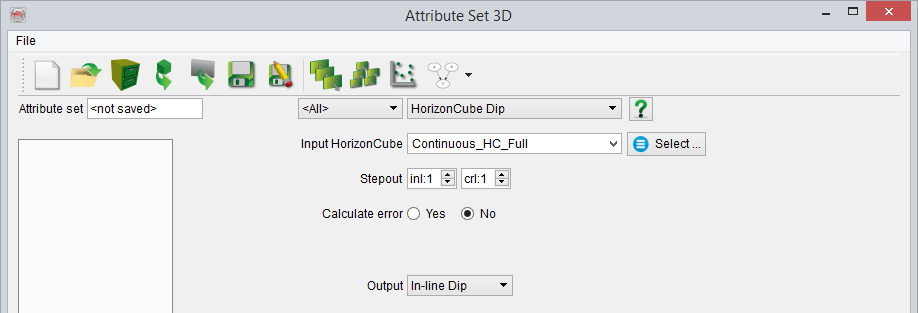5.3 HorizonCube Attributes
HorizonCube attributes are new geometrical attributes introduced by dGB Earth Sciences. These are purely stratigraphic attribute that help in identification and characterization of stratigraphic traps. These attributes can be computed directly from HorizonCube and stored as volume (as the Attribute Set Window does) or stored as a separate element such as HorizonCube Data, which contains grid based attributes. The advantage of computing HorizonCube attributes as a volume is that one could easily render it in 3D as one cannot easily render 100s of grids in 3D scene. Further advantage of this approach is that one could also integrate the HorizonCube attributes with conventional seismic attributes by using logical expressions or neural networks to characterize seismic data, to predict hydrocarbon traps etc.
Attribute Set Window
These attributes can be found in general OpendTect Attribute Set window, which can be launched via Analysis > Attributes > 3D/2D.
Using Attribute set window, one can define the following HorizonCube attributes:
HorizonCube Data
This attribute is used to convert the attributes that are stored under HorizonCube data into a volume. The input HorizonCube should be a 3D HorizonCube for this case as it is not supported for a 2D HorizonCube. The output field is populated if the selected 3D HorizonCube contains pre-computed HorizonCube Data. By default, the Interpolate option is set to yes as there could be gaps that you might want to fill. If you want to keep the gaps empty, set this option to No.
It is equivalent to OpendTect's basic attribute i.e. horizon. To read further, please follow the section below on Calculate attributes along HorizonCube.

HorizonCube Density
It is an 2D/3D attribute that defines the density of HorizonCube events within a defined time gate. It returns an event count, which defines total number of events within a time gate. The output values are number of events.

The attributes can be use to map or visualize pinchouts, unconformities, condensed intervals, etc. These objects will appear as high density values.
HorizonCube Dip
This attribute returns the dips of 2D/3D HorizonCube as a volume. The stepouts are the radii to compute the dips along each event. Larger stepouts define the regional dips along an event.

In order to QC the dips of HorizonCube vs. input SteeringCube, one may set the Calculate error field to Yes. This would allow you to select the parent SteeringCube to further evaluate the HorizonCube results. The errors are computed for each seismic sample by subtracting the dips of HorizonCube from the selected SteeringCube. The result is a dip difference. Lower dip errors mean that HorizonCube events do not deviate much from the selected SteeringCube and vice versa.

HorizonCube Layers
It is very convenient to visualize 100s of HorizonCube events in 3D scene. However, one could convert them into a volume and could easily render it in 3D. This attribute does such a job, which primarily governs to QC HorizonCube results.
The number of events per layer field allows to select how many events should be considered to defined a layer. The default value is set to 10, which means that each resultant layer contains at least 10 HorizonCube events. The output of this attribute is a range of values defining number of layers.

HorizonCube Thickness
It is a vertical thickness (isochron) between two HorizonCube events. It is also a trace attribute along the HorizonCube events. Such an attribute can also be used to visualize pinchouts or unconformities (zones of near zero thickness).


Example of HorizonCube attributes overlain on seismic data.
Calculate Attributes along 3D HorizonCube
These attributes are computed from the HorizonCube Control Center. The output of all of these attributes is a set of grids, which are collectively saved as HorizonCube Data. These attribute grids can be visualized using 3D Slider.
In the Select HorizonCube option, you can select the entire HorizonCube, or a package or an event.

General: This category is used to compute any existing attribute (stored or defined) along HorizonCube events. For instance, if you already have a stored AI or PHI volume and you would like to compute it along HorizonCube, you can use this option.
Centered Isopach: This attribute calculates the vertical thickness (TWT/depth) between two events such that they are centered by an event. In this manner, the thickness is computed along the centered event. Number of layers above/below define the relative number of events to compute the thickness. For instance, if the value for layers above/below is set to 1, for each central event, the thickness is computed by subtracting the TWT/Depth of an underlying event from the overlying event and storing the result for the central one.

Topographical Curvature: This attribute defines geometrical curvature of an event, attribute or HorizonCube Data. The stepouts are number of inlines/crosslines to be used to compute the curvature. These attributes are mostly equivalent to the conventional curvature attributes that are directly computed from the SteeringCube.

References
de Groot, P., Qayyum, F., On the Horizon, Oilfield Technology, p. 24-28, January 2013.
de Groot, P., Qayyum, F., Attributes play important role in seismic interpretation, Hart's E&P Magazine, p. 31-34, October 2012.
Weblink: OpendTect Attributes Table